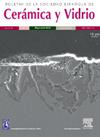Evolución tecnológica y arqueometría en el estudio de cerámicas de Fajalauza (Granada, España)
IF 2.7
4区 材料科学
Q1 MATERIALS SCIENCE, CERAMICS
Boletin de la Sociedad Espanola de Ceramica y Vidrio
Pub Date : 2024-11-01
DOI:10.1016/j.bsecv.2024.09.006
引用次数: 0
Abstract
An archaeometric study has been undertaken on a set of Fajalauza ceramic materials to in depth understand the technological characteristics and processing of one of the most unique productions of traditional Spanish ceramics. The set comprises a representative selection of fragments that encompass from the end of the Morisque period at the end of the fifteenth century to current productions of the twentieth and twenty first centuries. The fragments dated between the end of the fifteenth century and the middle of the nineteenth century come from recent preventive archaeological excavations carried out in different streets of Granada, while those from current productions come from both private collections and the current production of the Cecilio Morales factory. Clay samples from the old workshop of this factory were also analyzed for comparative purposes. The archaeometric characterization was accomplished using binocular magnifying glass, thin section petrographic observation, XRD, XRF and FESEM with EDS microanalyses. Chemical composition data were also subjected to a multivariate statistical analysis. The main results indicated a notable technological continuity between the seventeenth and twentieth centuries, detecting only discontinuities in the ceramics called Pre-Fajalauza, which differ in body composition and in glaze characteristics, and in the most recent ones of the twenty first century in which the SnO2 has been substituted by ZrO2 as opacifier in the glazes.
法哈劳扎(西班牙格拉纳达)陶瓷研究中的技术演变与考古学。
为了深入了解西班牙最独特的传统陶瓷产品之一的技术特点和加工工艺,我们对一套法哈劳扎陶瓷材料进行了考古研究。这套材料包括从十五世纪末莫里斯克时期末期到二十世纪和二十一世纪当前生产的具有代表性的碎片。十五世纪末至十九世纪中叶的碎片来自最近在格拉纳达不同街道进行的预防性考古发掘,而当前生产的碎片则来自私人收藏和西西里奥-莫拉莱斯工厂的当前生产。为了进行比较,还对该工厂旧车间的粘土样本进行了分析。考古鉴定是通过双目放大镜、薄片岩相观察、XRD、XRF 和 FESEM 以及 EDS 显微分析完成的。还对化学成分数据进行了多元统计分析。主要结果表明,十七世纪和二十世纪之间的技术具有显著的连续性,只有在被称为前法哈劳扎的陶瓷中发现了不连续性,这些陶瓷在坯体成分和釉面特征方面存在差异,而在二十一世纪的最新陶瓷中,釉面中的二氧化硫已被二氧化锆取代,成为不透明物质。
本文章由计算机程序翻译,如有差异,请以英文原文为准。
求助全文
约1分钟内获得全文
求助全文
来源期刊

Boletin de la Sociedad Espanola de Ceramica y Vidrio
工程技术-材料科学:硅酸盐
CiteScore
5.50
自引率
2.90%
发文量
72
审稿时长
103 days
期刊介绍:
The Journal of the Spanish Ceramic and Glass Society publishes scientific articles and communications describing original research and reviews relating to ceramic materials and glasses. The main interests are on novel generic science and technology establishing the relationships between synthesis, processing microstructure and properties of materials. Papers may deal with ceramics and glasses included in any of the conventional categories: structural, functional, traditional, composites and cultural heritage. The main objective of the Journal of the Spanish Ceramic and Glass Society is to sustain a high standard research quality by means of appropriate reviewing procedures.
 求助内容:
求助内容: 应助结果提醒方式:
应助结果提醒方式:


